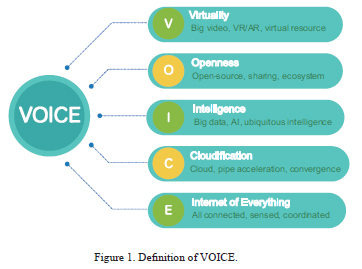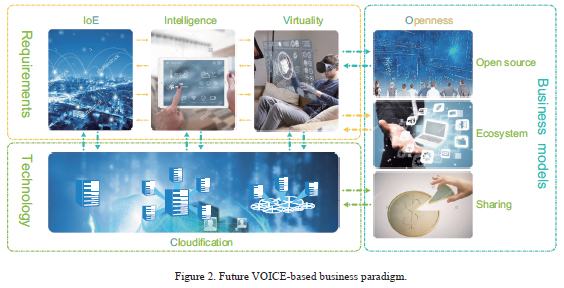M-ICT 2.0: VOICE for a Digital Future

The ICT industry develops dramatically. Anything that can be connected in the world will be made digital and interconnected to support future digital economy. The coming digital era will be defined by ubiquitous intelligence across all aspects of our lives. The most prominent trends will be big data and artificial intelligence (AI), and underpinning all the changes is the increasingly pervasive range of cloud computing platforms and services.
The emergence of the sharing economy and massive use of peer-to-peer networks have shown the way forward for businesses of all sizes. In response to this rapidly changing and dynamic landscape, ZTE has put forward its M-ICT 2.0 strategy that can help businesses seize opportunities in the new digital era.
ZTE has insights into five key trends that will influence and determine future industrial development. These trends are virtuality, openness, intelligence, cloudification and the internet of everything, encapsulated in the acronym VOICE. They will drive innovative collaboration and concurrent advances across various fields (Fig. 1).

ZTE believes that digital transformation will reach a critical stage of development within the next five years, with VOICE being the core foundation. Core elements such as manpower, material, process and data will be more connected within and between corporations; collaboration and interactions will be more efficient; and open collaboration and sharing will propel a major shift in business models.
In terms of user experience, the internet of everything enables information transfer and sharing through connected individuals, making it easier for people to perceive and act in the physical world. This flow of information helps create a virtual world with greater freedom of expression that pushes the experience to new heights.
With a combination of virtuality and reality, people can use virtual technology to reinforce their cognition and transformation of the physical world. Living in an increasingly complicated world mixed with virtuality and reality, people also need a simpler and easier way to manage their lives. Thus, greater intelligence stands out as an essential element in this digital future.
The concept of “all things digital” generates big data and builds environments for machine learning, while the internet of everything provides objects for artificial intelligence. The idea of “everything is connected, perceived and intelligent” helps people significantly increase productivity as well as quality of life.
The next five years will be critical in the ongoing global economic transformation towards an open, sharing, and digital economy. The VOICE concept will have a far-reaching impact on businesses and propel them into a new user-centric, technology-based, and business model-driven digital paradigm (Fig. 2). The internet of everything, intelligence, and virtuality represent requirements; cloudification provides technical support, and openness means new business models. All of them work together to result in the reconfiguration of R&D models, industry supply chains, and the overall value network.

ZTE will focus on the five trends of VOICE in the coming five years to develop its products and services. This will require extensive collaboration with users, partners and industries to achieve sustainable ICT development.
Virtuality means integration of physical and virtual worlds to enhance user experience through big video, VR and AR. Traditional customer requirements are oriented to functions and performance. Today customers pay more attention to optimal experience. Experience can be improved in two aspects: optimizing user experience (from abstract text, vivid picture to big video with 8K super HD resolutions) and improving interactive experience (from keys, touch screens to voice, gesture, and VR/AR interaction). Big video plus VR/AR applications will enhance the virtual world and create a more vivid experience. Big video has been widely applied in many industries, and VR/AR is expected to become the next-generation computing platform.
ZTE determines to grasp these emerging opportunities. For big video, ZTE will focus on the network and service platform, extend video conferencing applications, increase the use of multimedia chips and penetrate into the high-value video ecosystem. ZTE will also enhance VR/AR technology foundations through terminal and cloud integration, channel optimization, and more targeted industry focus.
Openness refers to the transition from traditional competition-based business model to close collaboration on an open basis. Business models are critical in innovation, and their innovation drives enterprise growth. Therefore, business models must be considered in the top-level design of the enterprise development strategy.
ZTE considers that openness is the core philosophy in business model innovation in this digital era. Openness involves development in open source, ecosystems, and the sharing economy. It will bring about a reconfiguration in R&D models, industry supply chains, and the value network.
ZTE determines to adopt three-reconfiguration strategy for business model innovation in three major fields: open sources, ecosystems, and sharing economy. ZTE will focus on open source communities in the operator, chip, and ICT infrastructure domains, and develop ecosystems in terminal, smart city and IoT fields. Regarding to the sharing economy, ZTE will pay attention to transformation opportunities, enable the transformation, and run it if necessary.
Intelligence
Intelligence will be ubiquitous and interactive in the future society. Artificial intelligence will be upgraded rapidly and will even surpass the intelligence of human beings. ZTE divides intelligence development into four levels: basic intelligence, computing intelligence, perception intelligence, and cognitive intelligence. Basic intelligence is initiated by sensors appearing everywhere and supporting smart hardware. Computing intelligence supports data mining where data is processed and analyzed to build the basics of the digital economy—big data apps. Perception intelligence means to enhance human auditory and visual sensation. Cognitive intelligence is to drive self-learning and conscious decision-making.
ZTE has adopted relative policies to grasp the opportunities of intellectualization:
● Use various perception technologies, especially machine vision and natural language processing, to offer integrated solutions.
● Focus on chips, OS, and modules related to intelligence processing to enable smart hardware and terminals.
● Focus on big data platforms and cloud infrastructure for exploring key industrial operations and the value of big data.
● Accumulate operational capabilities for the cognitive platform.
Cloud computing has pushed the development of IT applications of various industries in terms of technical architecture and business model. The traditional IT application architecture is shifting to cloud architecture. The business model for enterprise IT systems will gradually change from self-build and self-maintenance to public cloud and hybrid cloud service. Cloud computing not only changes enterprise IT architecture and business models but also drives telecom networks to evolve towards software-defined, flexible, and open architecture.
ZTE has summed up its cloudification strategy in four aspects: terminal and pipe acceleration, IT upgrade, platform cloudification, and operation extension.
● Terminal and pipe acceleration: Terminal acceleration means to focus on ZTE’s two main terminal series. AXON and Blade to carry out value innovation, while pipe acceleration means to maintain network upgrade according to Moore’s law and evolve telecom networks to ElasticNet architecture (Fig. 3). ZTE has capitalized on SDN/NFV opportunities to deliver cloud products and solutions, including multi-level distributed cloud deployment, network slicing on-demand, and shortcut functions designed for new application scenarios. ZTE has also enabled function componentization and decoupling to the maximum extent and strict isolation of the control plane from the user plane or the forwarding plane.

● IT upgrade: ZTE is committed to providing advanced IT infrastructure based on cloud architecture. ZTE will grasp every technology innovation opportunity, use open source to cross technical barriers, and improve its competitiveness in products and solutions.
● Platform cloudification: ZTE focuses on developing PaaS capabilities and products. In traditional operator markets, ZTE will enhance the PaaS policy to help operators transform to digital service operation. The PaaS impact will extend from internal to external, i.e., from inner cloud-based applications to external smart city and other key industrial applications.
● Operation extension: ZTE will develop the enterprise cloud services market based on smart city applications, and exploit vertical cloud applications in finance and manufacturing.
All things in the world can be digitalized and interconnected. It is estimated that 50 billion devices will be connected to the Internet by 2020. Although IoT applications are booming, the application fragmentation problem needs to be solved through greater industry collaboration and cloud computing. The IoT industry supply chain is more complex, and IoT business model needs to be innovated for further IoT service deployment and industry ecosystem development.
ZTE has extended connections and terminals, developed the platform, and focused on key industry applications. The strategy is summarized as “two platforms, three horizontal aggregations, and four vertical fields”. The two platforms are ecosystem platform and capital platform. The three horizontal aggregations refer to terminals, networks, and IoT PaaS. The four vertical fields contain smart home, industrial internet, internet of vehicles, and smart city.